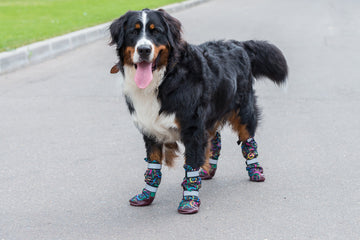7 Min Read
Do Dogs Need Boots in Winter?
Key takeaway

Why pet owners are switching to online vet care with Dutch
-
Prescriptions delivered free to you
-
Fast access to Licensed Vets over video
-
Unlimited video visits and follow-ups
Although they look cute, you may wonder if dog boots are necessary during the rainy winter or hot summer months. While your dog’s paw pads can handle walking on rough surfaces in different environments, dog boots may be necessary to protect their paws in extreme temperatures, such as winter.
Keep reading to learn why dogs need booties in the winter and how else you can protect your pup’s paws.
- Benefits of Dog Booties in Winter
- When Are Dog Boots Not Necessary?
- How to Choose The Right Pair of Dog Boots
- Training Your Dog to Wear Boots
- Do Dogs Need Booties?: FAQs
- Other Ways to Protect Your Dog’s Paws
- Final Notes
Benefits of Dog Booties in Winter
Dog booties aren’t just a cold-weather fashion statement. Dogs need boots in winter to protect their feet from extreme temperatures and the hazards that come along with it. Read along to learn about the benefits of dogs wearing shoes in winter:

Protection against extreme weather
Just like cold, snowy terrain would make your bare feet cold, it will make your dog’s feet cold, too. In the same way a sweater for your dog is a good tool to keep their body warm, dog boots offer a layer of protection to help keep their feet warm as they trek over ice, snow, and more. If you’ve ever noticed your dog excessively licking and chewing their paws or having difficulty walking, or if their paws become cracked in winter, it may be a sign that your dog needs dog boots.
Dog boots can also protect against sharp ice or rocks, cold snow, and other potential hazards that may injure your dog’s paws.1
Protection from road salt
Road salt, also known as de-icing salt, is used in the winter to help make snow melt more quickly. Unfortunately, this salt is a serious hazard for your dog. Exposure to road salt can cause skin irritation, dry and cracked paws, blisters, and other injuries. Dogs need booties to protect their sensitive feet.
Injury prevention
No matter the time of year, dog booties are a great way to help protect your dog from foot injuries, whether from rocks, cold snow, thorns, or other hazardous objects.1 If you take your dog hiking in winter or live in an area where broken glass and other road debris may be a concern, dog shoes in winter are a must.
Easy clean up
Dog boots are also a great way to keep your dog and home clean in wintertime. They minimize the tiresome task of cleaning mud, snow, and dirt from your pet's paws after every walk. That means less dirt tracked through your home!
Better stability
Icy surfaces can be slippery for dogs and humans alike! A pair of dog booties can give your dog some much-needed traction on slippery surfaces, especially for older pups or those with mobility issues.
If your dog struggles with walking, you may want to speak with your vet about non-slip, orthopedic dog boots for winter. This can help dogs with arthritis, hip dysplasia, and other conditions.1 Talk to your vet about which boots may be the best option for your pet.

When Are Dog Boots Not Necessary?
Despite the benefits, there are times when dog boots may be a burden to everyday life, especially if your pooch is adverse to wearing them. Your pup may be picky about what they put on their feet, so we recommend testing a few pairs before using them regularly.
If your dog is struggling to adjust, it may be better to avoid shoes until they feel more comfortable. Otherwise, they may try to chew and remove them. Additionally, your dog will experience discomfort if their boots don't fit correctly. Ill-fitting shoes can disrupt your dog's mobility, leading to slips, falls, blisters, and sores.
In many cases, dog boots aren’t necessary on daily walks. A dog's paw pads are usually strong enough unless you live in an area prone to extreme weather conditions.2 However, if you live somewhere with milder weather and your dog doesn’t spend too much time outdoors, boots may not be a necessity for you. Instead, consider learning how to keep your dog safe and exercise indoors during harsh weather.

How to Choose The Right Pair of Dog Boots
In order to choose the right pair of boots, you must measure your dog’s feet. As mentioned previously, ill-fitting shoes can lead to discomfort. Remember to measure regularly if your dog is still young and growing and keep their nails trimmed for a better fit.2
You must also know why you're buying the boots. What kind of terrain does your dog struggle with? Is it due to colder temperatures? Hotter weather? These kinds of factors will impact your buying decision. It can be worth spending a bit more money on shoes that are better quality and made from comfortable, lightweight materials that will make all the difference in your dog’s enjoyment.
Felt or fleece boots can be quite effective with picky dogs as they're more malleable, but they'll also get wet in damp or snowy weather, making your dog’s feet even colder than before. Waterproof fabric and non-slip soles will help keep your dog’s feet dry and clean.
Training Your Dog to Wear Boots
One tip to help your pup adjust to wearing booties is to use the “one paw at a time” method. Doing so allows them to walk with just one shoe before introducing all four.
It will be a case of trial and error but don’t give up hope. Many dogs are initially resistant to boots, but they need time to adjust. Try positive reinforcement and reward your dog whenever they interact with the shoes. Most importantly, be patient with your furry friend; they'll get there!

Do Dogs Need Booties?: FAQs
At what temperature do dogs need booties?
Whether your dog should wear boots should be based on the type of terrain your pup is walking on rather than the temperature outside. You'll also have to take into account their behavior or symptoms. For example, they may be noticeably shivering or have cracked, dry paws or skin. If you're still unsure, speak to a licensed veterinarian today for advice to determine if your dog should wear booties or not.
Should dogs always wear boots outside?
In some circumstances, yes. If the weather conditions are extreme, it can be beneficial for dogs to wear shoes on their daily walks outside to protect their paws from damage. That said, dog paws are designed to endure running on all sorts of terrains, and if the conditions are mild, your dog will most likely not need them.
What are good alternatives for dog boots?
If your dog is against wearing booties, you can always try a thin, protective layer of paw wax to prevent damage. In this case, you must rinse and dry their paws with warm water when you return inside.2 To minimize cracking, ensure their paws are hydrated with a dog-friendly conditioner or paw balm.
Other Ways to Protect Your Dog’s Paws
Dog booties aren’t the only way to protect your dog’s feet in colder months. In addition to using dog shoes in winter, explore these:
- Paw moisturizers: Paw balms, waxes, and even simply petroleum jelly can be great tools for retaining moisture in your dog’s paws.
- Clean paws after going outside: It’s important to clean your dog’s paws every time they go outside in winter, even if just for a quick pee. Wipe with a damp towel to remove any dirt, snow, ice, or chemicals.
- Regularly groom their paws: Long-haired dogs are susceptible to ice balls forming on their paws. Keep their paw hair short in winter to minimize their risk.
- Keep their nails short: The longer your dog’s nails, the more their toes spread as they walk. That means snow, dirt, chemicals, and other debris has an easier time getting in-between their toes and causing irritation. Keep your dog’s nails trim to avoid this.
Final Notes
Does your dog need boots in wintertime? Absolutely. Dog booties are a great way to keep your dog warm, protect them from the snow, ice, and de-icing salts, give them a stability boost, and more. Combine dog booties with other protective measures, like regular cleaning, grooming, and moisturizing, for optimal protection against the cold.
Interested in learning other tips to help your dog live their best life? Dutch is here to help. Dutch members get unlimited access to licensed veterinarians. Ask questions, get recommendations, and more. Contact Dutch today to get started.
Share
References
-
“Protect your dog’s paws from winter weather” Animal Humane Society, https://www.animalhumanesociety.org/resource/protect-your-dogs-paws-winter-weather.
-
Staff, AKC. “Best Dog Boots for Winter & Cold Weather.” American Kennel Club, 13 Dec. 2022, https://www.akc.org/expert-advice/lifestyle/dog-boots-for-winter/.
-
Waldorf Gewitz, Elaine. “How Hot is Too Hot for Dogs Paws?” American Kennel Club, 04 Aug. 2021, https://www.akc.org/expert-advice/home-living/dog-paws-hot-pavement/.




